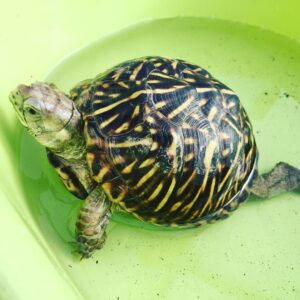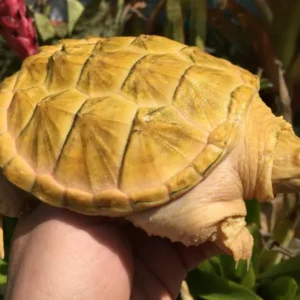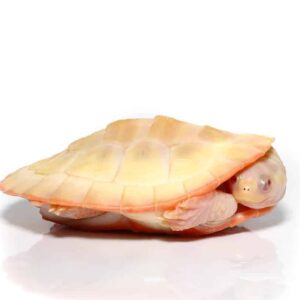Baby Albino Pinkbelly Side neck Turtle For Sale
$599.99
WE HAVE BABY ALBINO PINKBELLY SIDE NECK TURTLE FOR SALE. HERE ARE SOME HIGHLIGHTS:
- Emydura subglobosa
- Captive Bred Babies
- Approximately 1.5 – 2 Inches In Length
- Adults Can Get Up To 10 Inches In Shell Length
- Feeding On Hatchling Turtle Pellets & Silversides
FUN FACTS!
- Very Rare Color Morph Of This Beautiful Species
- Naturally Occurring In Freshwater In New Guinea, And Australia
- With Proper Care These Turtles Can Live 30 – 50+ Years In Captivity
- These Are Highly Aquatic Turtles Living In Warmer Water Around (75 – 82 Degrees) Along With A Dry Dock For Them To Bask
Description
The Albino Pinkbelly Side Neck Turtle, scientifically known as Emydura subglobosa, represents a captivating variant of the standard Pinkbelly Side Neck Turtle. Indigenous to the freshwater rivers and wetlands of Australia and New Guinea, these turtles thrive in warm, slow-moving waters abundant with aquatic vegetation and basking sites. Their habitats provide an ideal environment for their semi-aquatic lifestyle, which combines swimming and sunbathing on exposed rocks and logs.
The Albino Pinkbelly Side Neck Turtle is distinguished by its unique physical characteristics, most notably its striking coloration. Unlike the typical Pinkbelly Side Neck Turtle, which exhibits a dark shell with a pinkish hue on its belly, the albino variant possesses a pale, almost translucent shell with a pronounced pink belly that stands out vividly. This distinct coloration results from a rare genetic mutation that inhibits the production of melanin, the pigment responsible for darker colors in the skin, shell, and eyes. Consequently, the albino variant sports a lighter, more ethereal appearance, making it an intriguing subject for reptile enthusiasts and researchers alike.
In addition to its remarkable coloring, the Albino Pinkbelly Side Neck Turtle shares several morphological traits with its non-albino counterparts. Both variants feature a distinctive side-necked posture, where the turtle retracts its head sideways into its shell rather than pulling it directly back. This characteristic is an evolutionary adaptation that enhances their ability to protect themselves from predators. Furthermore, they possess webbed feet and streamlined bodies, which facilitate efficient swimming and maneuvering in their aquatic habitats.
The albino Pinkbelly Side Neck Turtle’s unique genetic traits and captivating appearance not only distinguish it from the standard variant but also contribute to its appeal as an exotic pet. However, its rarity and specialized care requirements necessitate a commitment to understanding and catering to its specific needs, ensuring its health and well-being in captivity.
Natural Habitat and Distribution
The Albino Pinkbelly Side Neck Turtle, a unique variant of the Emydura subglobosa species, thrives predominantly in freshwater environments. These turtles are typically found in slow-moving rivers, swamps, and other aquatic habitats with abundant vegetation. Their preference for such environments is linked to their need for clean, warm, and shallow waters, which provide them with ample basking sites and abundant food sources.
Geographically, the Albino Pinkbelly Side Neck Turtle is most commonly found in regions of Australia and New Guinea. In Australia, they are primarily located in the northern territories and Queensland, while in New Guinea, they inhabit the southern parts of the island. These regions offer the warm, tropical climate that is essential for their survival and well-being.
Crucial environmental conditions for the Albino Pinkbelly Side Neck Turtle include water temperatures ranging from 75 to 85 degrees Fahrenheit, and a pH level between 6.5 to 7.5. These conditions ensure that the turtles can maintain their metabolic functions and overall health. Additionally, the presence of submerged logs, rocks, and dense aquatic plants is vital as it provides shelter and breeding sites, thus supporting their natural behaviors and life cycle.
Understanding the natural habitat and distribution of the Albino Pinkbelly Side Neck Turtle is essential for conservation efforts. As human activities and climate change continue to alter these environments, it becomes increasingly important to monitor and protect the habitats that sustain these remarkable reptiles. By preserving their natural ecosystems, we can ensure the continued existence of the Albino Pinkbelly Side Neck Turtle in the wild.
Physical Characteristics and Unique Features
The Albino Pinkbelly Side Neck Turtle distinguishes itself with its striking and unique appearance. This distinctiveness begins with its size, where adult turtles typically measure between 5 to 9 inches in length. The shell, or carapace, of the Albino Pinkbelly Side Neck Turtle is slightly domed and elongated, providing a streamlined shape that aids in aquatic navigation. When compared to their non-albino counterparts, the albino turtles maintain a similar shell structure but exhibit a vastly different coloration.
The most prominent feature of these turtles is their albino trait, which results from a genetic mutation that inhibits the production of melanin, the pigment responsible for coloration in many animals. This absence of pigmentation manifests in their unique pinkish hue, particularly noticeable on their underbelly or plastron. The carapace of the Albino Pinkbelly Side Neck Turtle often displays a pale, almost translucent quality, ranging from a creamy white to a soft pink shade. Their skin follows suit, with pinkish tones replacing the usual darker shades found in non-albino Pinkbelly Side Neck Turtles.
Additionally, the eyes of the Albino Pinkbelly Side Neck Turtle are another striking feature. Due to the lack of pigmentation, their eyes often appear red or light pink, a stark contrast to the typical dark eyes of their non-albino counterparts. This eye coloration not only enhances their unique appearance but also can be a point of vulnerability, as the lack of pigmentation can make them more sensitive to light.
In summary, the Albino Pinkbelly Side Neck Turtle’s physical characteristics and unique features are deeply influenced by their albino trait. The absence of pigmentation sets them apart from non-albino Pinkbelly Side Neck Turtles, resulting in a captivating and rare aesthetic that continues to intrigue enthusiasts and researchers alike.
Behavior and Temperament
The Albino Pinkbelly Side Neck Turtle is a fascinating species, not only for its striking appearance but also for its distinctive behavior and temperament. These turtles are known for their moderate activity levels, often seen basking under the sun or exploring their aquatic surroundings. Unlike some other turtle species, they exhibit a relatively calm demeanor, making them suitable for both novice and experienced reptile enthusiasts.
Socially, the Albino Pinkbelly Side Neck Turtle tends to be more solitary. While they can coexist with other turtles in the same habitat, it is crucial to monitor their interactions to prevent any potential aggression. They are generally non-confrontational but can become territorial if they feel threatened, especially during feeding times. Providing ample space and hiding spots within their enclosure can mitigate these issues.
Interactions with other species should be approached with caution. The Albino Pinkbelly Side Neck Turtle may not display overt aggression, but their unique coloration can sometimes make them a target for more dominant turtles. It is advisable to house them with species of similar size and temperament to ensure a harmonious environment.
One of the unique behavioral traits of the Albino variant is their sensitivity to light. Due to the lack of pigmentation, they can be more prone to sunburn and other light-related issues. This necessitates careful regulation of their exposure to UV light, both for basking and within their habitat. Unlike their non-albino counterparts, they may exhibit more frequent hiding behavior to shield themselves from excessive light.
In terms of feeding, the Albino Pinkbelly Side Neck Turtle is omnivorous, with a diet that includes aquatic plants, insects, and small fish. They are generally enthusiastic eaters and can be trained to recognize feeding times, displaying a more active and alert behavior when food is introduced to their environment.
Overall, the Albino Pinkbelly Side Neck Turtle’s behavior and temperament make them an intriguing subject of study and a delightful pet for those willing to accommodate their specific needs.
Diet and Feeding Habits
The Albino Pinkbelly Side Neck Turtle, known for its unique coloration and captivating appearance, requires a well-balanced diet to maintain optimal health. In the wild, their diet is diverse, consisting of both plant-based and animal-based food sources. These turtles are omnivorous, meaning they consume a variety of foods to meet their nutritional needs.
In their natural habitat, Albino Pinkbelly Side Neck Turtles primarily feed on aquatic vegetation, algae, and various types of water plants. These plant-based foods are crucial as they provide essential vitamins and fibers. Additionally, they consume small fish, insects, crustaceans, and mollusks, which offer the necessary proteins and fats required for their growth and energy.
In captivity, it is essential to replicate their natural diet as closely as possible. A balanced diet for an Albino Pinkbelly Side Neck Turtle should include fresh leafy greens like lettuce, kale, and dandelion greens. Aquatic plants such as duckweed and water lettuce can also be added to their diet. Protein sources should include commercial turtle pellets, which are specifically formulated to meet their dietary requirements, as well as occasional feedings of live or frozen insects, small fish, and shrimp.
Feeding these turtles properly involves offering a varied diet and avoiding overfeeding, which can lead to obesity and other health issues. It is recommended to feed adult Albino Pinkbelly Side Neck Turtles every two to three days, ensuring that they receive a mix of both plant and animal-based foods. Juveniles, on the other hand, require more frequent feedings, typically once every day, due to their higher growth rate.
Ensuring clean water and a well-maintained habitat is also crucial for the turtle’s health. Uneaten food should be removed promptly to prevent water contamination. By providing a balanced and varied diet, along with proper feeding practices, owners can help their Albino Pinkbelly Side Neck Turtles thrive in captivity.
Breeding and Lifespan
The Albino Pinkbelly Side Neck Turtle, a captivating species, exhibits intriguing breeding habits and a distinct reproductive cycle. Mating typically occurs during the warmer months, wherein males engage in courtship behavior to attract females. This behavior often involves gentle biting and an elaborate display of head movements. Once mating is successful, females proceed to lay their eggs.
Egg-laying generally takes place in sandy or soft soil areas where females can dig shallow nests. Each clutch usually contains between 8 to 20 eggs, although this number can vary depending on the age and size of the female turtle. The incubation period for Albino Pinkbelly Side Neck Turtle eggs ranges from 60 to 90 days, influenced by environmental conditions such as temperature and humidity. Optimal incubation temperatures are crucial for the development of the embryos, with higher temperatures often resulting in a higher proportion of female hatchlings due to temperature-dependent sex determination.
In terms of lifespan, Albino Pinkbelly Side Neck Turtles can live significantly long lives. In their natural habitats, these turtles generally have a lifespan of 20 to 30 years. However, when kept in captivity with proper care, they can live even longer, often reaching up to 40 years or more. Several factors influence their longevity, including diet, habitat conditions, and overall health care. A balanced diet rich in proteins, vitamins, and minerals is essential, along with a clean and well-maintained environment.
Moreover, the absence of predators and the provision of medical care in captivity contribute to their extended lifespan. Regular veterinary check-ups and a habitat that mimics their natural environment as closely as possible are imperative for ensuring their well-being and longevity. Understanding the breeding habits and lifespan of the Albino Pinkbelly Side Neck Turtle not only enriches our knowledge but also aids in their conservation and proper care in both wild and captive settings.
Conservation Status and Threats
The Albino Pinkbelly Side Neck Turtle, a captivating variant of the Pinkbelly Side Neck Turtle, faces numerous challenges in its natural habitat. Classified under the broader category of freshwater turtles, their conservation status is of increasing concern due to a variety of threats. Habitat destruction stands as one of the most significant issues, with wetland drainage, deforestation, and urban development contributing to the loss of their natural environments. These activities result in fragmented habitats, making it difficult for populations to thrive and reproduce effectively.
Pollution further exacerbates the situation, with chemical runoff from agriculture and industrial waste contaminating water bodies. This not only affects the water quality but also impacts the turtles’ food sources, leading to a decline in overall health and reproductive success. Additionally, climate change poses a looming threat by altering weather patterns and water temperatures, which can disrupt the delicate ecological balance these turtles rely on.
Illegal pet trade also significantly endangers the Albino Pinkbelly Side Neck Turtle. Their unique appearance makes them highly sought after, leading to over-collection from the wild. This unsustainable practice depletes natural populations and disrupts local ecosystems. Despite regulations and laws aimed at curbing illegal trade, enforcement remains a challenge, necessitating continuous monitoring and stricter measures.
Conservation efforts are crucial in addressing these challenges. Various organizations and initiatives focus on habitat restoration, pollution control, and stricter enforcement of wildlife trade regulations. Protected areas and breeding programs are also established to ensure the survival of these turtles. Public awareness and education play a pivotal role in these efforts, emphasizing the importance of preserving natural habitats and discouraging illegal pet trade.
Responsible pet ownership is essential to prevent further endangerment. Potential pet owners must ensure they source turtles from reputable breeders and not from the wild. Understanding the specific care requirements and committing to providing a suitable environment can significantly contribute to the conservation of the Albino Pinkbelly Side Neck Turtle. Collectively, these efforts can help secure a future for this unique and fascinating species.
Care and Maintenance in Captivity
Keeping an Albino Pinkbelly Side Neck Turtle as a pet requires significant commitment and attention to detail. These unique turtles have specific care needs to ensure they remain healthy and thrive in captivity. Setting up an appropriate habitat is the first step. A spacious aquarium with a minimum capacity of 40 gallons is recommended for a single turtle, with additional space required for each additional turtle. The habitat should include both aquatic and terrestrial areas to allow for swimming and basking.
Water quality is paramount for the well-being of Albino Pinkbelly Side Neck Turtles. The water in the tank should be kept clean and free of contaminants, with regular filtration and weekly partial water changes. Maintaining a water temperature between 75-80°F (24-27°C) using a reliable aquarium heater is crucial. Additionally, a basking area with a temperature of 85-90°F (29-32°C) should be provided, along with a UVB light source to facilitate proper shell and bone development.
Dietary requirements for Albino Pinkbelly Side Neck Turtles involve a mix of protein and plant-based foods. A balanced diet can include commercial turtle pellets, supplemented with fresh vegetables like leafy greens and occasional treats such as insects or small fish. It is important to avoid overfeeding, which can lead to obesity and other health issues.
Handling these turtles should be done with care, as they can become stressed if mishandled. Frequent handling is not recommended, and when necessary, it should be done gently. Regular health monitoring is essential. Owners should look out for common health issues such as shell rot, respiratory infections, and parasites. Any signs of illness, such as lethargy, loss of appetite, or unusual behavior, should prompt a visit to a veterinarian experienced with reptiles.
In conclusion, the Albino Pinkbelly Side Neck Turtle can be a rewarding pet for those prepared to meet its care requirements. Proper habitat setup, vigilant water quality management, appropriate diet, and attentive health monitoring are key to ensuring these fascinating turtles lead a healthy and fulfilling life in captivity.






